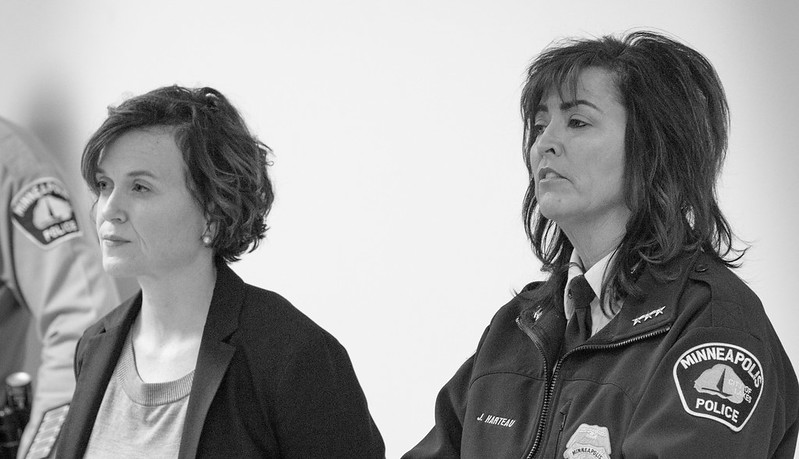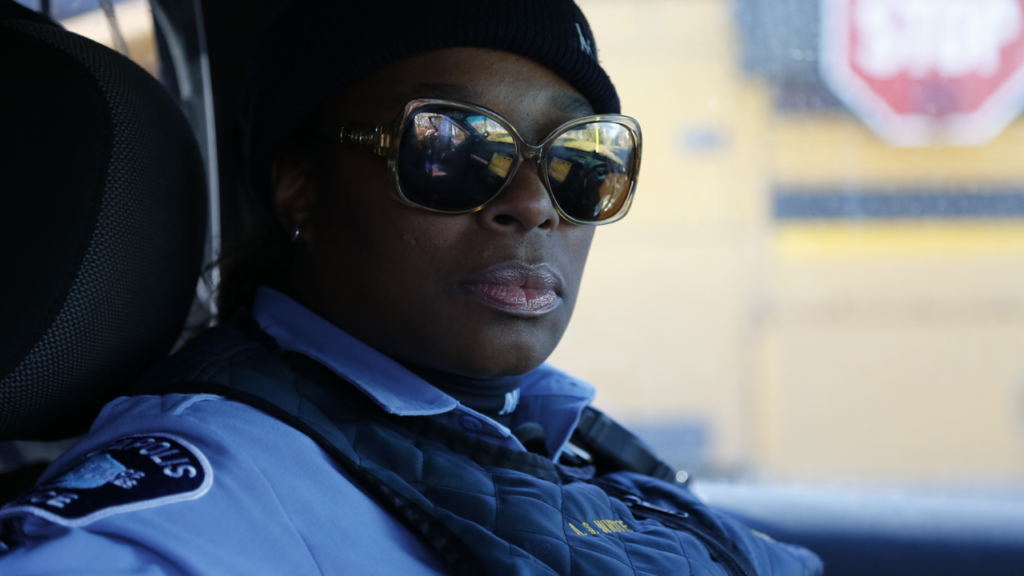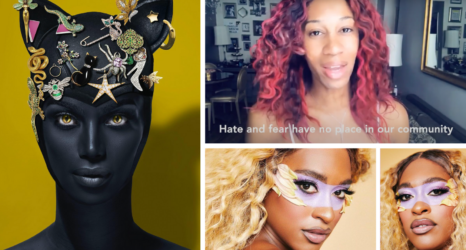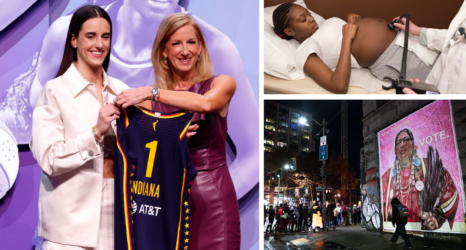Less than 48 hours after the debut of a documentary about the Minneapolis Police Department, a male police officer knelt on the neck of an unarmed Black man as three other male police officers either knelt on his back and legs or stood by watching. Nearly nine minutes later, George Floyd was dead. Most media reports mention the races of the four police officers—two white, two Asian. Few, if any, mention their gender.
“Could George Floyd’s death have been prevented had there been women police officers on the scene? It’s likely,” says Kathy Spillar, executive director of the Feminist Majority Foundation and executive editor of Ms.
That’s one of the main themes of the documentary, “Women in Blue,” which had its first screening on May 23 as part of the Minneapolis St. Paul International Film Festival; it was shifted to a virtual event as the city continued to shelter in place in response to the COVID-19 pandemic. The documentary follows five female police officers—including former Minneapolis Police Chief Janeé Harteau, the city’s first female police chief.

The 82-minute film highlights the attributes women bring to police departments and asks, “What could policing look like if there were more women? [and] What skills do we want our officers to have?” said the director, Deirdre Fishel, an independent director and associate professor at City College of New York, during a post-screening virtual Q&A.
Multiple studies spanning 50 years show that female officers lead with deescalation and communication, while male officers are more likely to lead with force and aggression. A landmark report by an independent commission convened after the 1991 beating by LAPD of Rodney King found, “Many [LAPD] officers, both male and female, believe female officers are less personally challenged by defiant suspects and feel less need to deal with defiance with immediate force or confrontational language.”
A 2002 study of seven major U.S. police departments by the National Center for Women and Policing found that “The average male officer is over eight and a half times more likely than his female counterpart to have an allegation of excessive force sustained against him … [and] two to three times more likely than the average female officer to have a citizen name him in a complaint of excessive force.”
Subsequent studies found that female police officers use less extreme forms of violence and less controlling behaviors; are less involved in corruption and sexual misconduct than their male counterparts; and conclude, “Hiring more women as police officers may help to reduce excessive force.”
“Police departments have failed to make changes in who they are hiring to adjust to what communities want from officers today,” says Spillar.
She points out that the hiring of police recruits is anchored to standards drawn up in the 1960s and 70s by two national commissions on law enforcement administration, when officers were recruited for physical strength, rather than the critical thinking and communication skills needed for community based policing.
“The problem is police departments continue to hire the wrong kind of person. We are not saying that only women are qualified to be police officers,” Spillar continues. “We are saying there should be equal numbers of women who reflect the diversity of the communities they serve. It would revolutionize police departments.”
“Officer-Involved Shootings Almost Always Include the Male Officers.”
As the documentary opens, cameras follow Harteau into a crowded room at the Minneapolis Police Department. Her narrative intersperses with the natural sounds of congratulatory chatter as she greets proud family members settling in for a police promotion ceremony.
“Officer-involved shootings almost always include the male officers. Excessive force complaints; very seldom with women,” said Harteau, the voiceover as the ceremony begins. “We have to diversify our police departments.”
The camera catches the promotion of one officer after another.
“But the role of women in policing is often overlooked,” said Harteau, her narrative continuing as the camera captures her shaking the hand of a female officer promoted to Sergeant. “Now every rank in this department is held by a woman or women, which is very unique.”
After the 2017 shooting death of an unarmed white woman, Justine Damond, by a male police officer, an incident that followed the 2015 shooting death of an unarmed African American man, Jamar Clark, by a male police officer, Harteau was asked to resign.
“Had I been there, maybe it would have had a different outcome,” said Sergeant Alice White of Clark’s death. “We have a different perspective on how to react than our male counterparts.”

White, who grew up in Minneapolis, is one of the officers spotlighted in the documentary.
“Policing really comes from your heart,” said White, who became a police officer so she could police the way she wished officers had policed when she was a child after some “not that great” interactions with the Minneapolis Police.
Spillar says anecdotal stories such as White’s support the few studies that have been done about why people become police officers. “Women police more often say they want to help their communities; men say policing is about using force to gain compliance with the law.”
The Reality
Since the Rodney King incident, there has been an increased focus on curbing police violence in the U.S. Rules and legislation enacted include body cameras and new training programs. In the wake of Floyd’s death, there are reports of renewed calls from activist organizations and academicians for more legislation to change the standards for legal use of force, to add implicit bias awareness training and training that teaches officers how to intervene. And a Washington Post opinion piece by Houston’s police chief suggests, “To avoid failing,” there must be even more “accountability” and better education that begins at the police academy.
“Everybody immediately goes to ‘we’ve got to train better, we’ve got to have more rules and regulations,’” says Spillar.
Despite the added measures, the number of people killed by police each year has remained unchanged, hovering at 1000. The other thing that has remained unchanged is the number of women on police forces.
“We need to start realizing, you cannot train the wrong person to do the right thing,” says Spillar.
The Difference Reality Makes
Gender imbalance can make for a challenging work environment with a lot of rules for female police officers, says former Minneapolis Police Inspector Catherine “CJ” Johnson.
“Act enough like the guys so they can believe that you can help if things go to hell; but, not so much like the guys that they feel threatened.”
There are also a lot of labels.
“You’re either seen as a mother, a bitch or a whore,” says former Minneapolis Police Commander Melissa Chiodo—who says she earned the “bitch” title because she reported and held accountable officers who used excessive force.
Television and movies make it appear that crime fighting is a gender balanced occupation in which discrimination and a hostile work environment don’t exist. There are tons of famous female cops, from Angie Dickinson as Sergeant “Pepper” Anderson, one of TV’s original female cops from the 1970s hit Police Woman, to Mariska Hargitay’s portrayal of Olivia Benson on Law and Order: SVU since 1999.
The reality is, only 12 percent of the nation’s police officers are women and that number has remained stagnant for more than 25 years. Fewer than 5 percent of the country’s largest cities have female police chiefs. At the time “Women in Blue” was filmed, Harteau oversaw an 850 person department that was 16 percent female; only six of the women were African American.
But, when Chief Harteau left the force, the department shifted back “from a female-run department to the standard male-run department,” says Johnson, who headed up the city’s Third Precinct. After 22 years on the force and soon after Harteau’s departure, Johnson left the force because it began “losing female perspective in a profession dominated by male voices.”
Chiodo left too. She had been running the special crimes unit. “When Chief Harteau offered me the job, I knew this is what I’d been waiting for,” says Chiodo who was working on changes to sexual assault protocol in the seven units she managed. She didn’t like the old model which makes the victim the criminal.
“What 14-year-old boy or girl says, ‘I want to have sex with a 50-year-old man and make $25 off of it, and maybe have him slap me around?’ They don’t.”
Soon after the new police chief, Medaria Arradondo, was sworn in, he reassigned Chiodo to Internal Affairs. A few months later, after 21 years, she left the force.
“I don’t think that focusing on women in leadership is a thought process for most men,” says Harteau. “I expected the men to carry that forward,” she says.
“It’s hard to grow your female ranks when you are still run by all males,” says Chiodo. “They don’t understand that the difference we bring is value. Law enforcement needs to change to make room for women to make policing better in America.”
“There should be an urgency now to increase the percentages of people who use communication and deescalation skills,” says Spillar. If you did that, “You’d have a very different type of police.”





